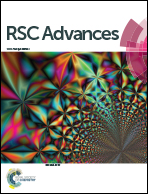Dual role of hydrogen peroxide on the oxidase-like activity of nanoceria and its application for colorimetric hydrogen peroxide and glucose sensing†
Abstract
Nanoceria (cerium oxide nanoparticles) exhibits excellent catalytic activity towards chromogenic substrate 3,3,5,5-tetramethylbenzidine (TMB) in the presence of hydrogen peroxide (H2O2), which has been reported. However, the understanding of the interaction between H2O2 and nanoceria is far from comprehensive. Herein, we further studied the interaction between H2O2 and dextran-coated nanoceria and found that H2O2 plays a dual role in nanoceria's oxidase activity both as an inhibitor and a promoter, depending on its concentration. At millimolar levels, H2O2 can promote nanoceria's oxidase activity; however, micromolar concentrations of H2O2 can inhibit its catalytic activity. In addition, this inhibiting effect is linearly dependent on the concentration of H2O2. Based on these findings, a simple, rapid and highly sensitive colorimetric method was established for the determination of H2O2 with a limit of detection (LOD) of 2.5 μM (3σ/slope) and a linear range from 4−40 μM. When coupled with glucose oxidase, glucose can be detected down to 2 μM in the linear range of 4−40 μM. Furthermore, this method was successfully applied in the determination of glucose in mouse serum samples. With the new understanding of the interaction between H2O2 and nanoceria, applications of nanoceria-based sensors in engineering, biotechnology and environmental chemistry can be further exploited.


 Please wait while we load your content...
Please wait while we load your content...